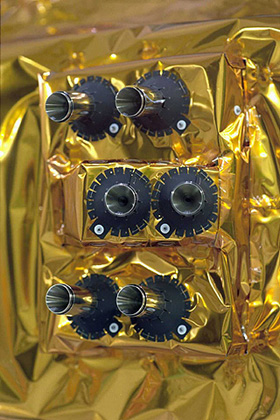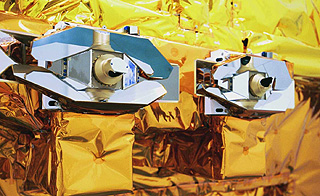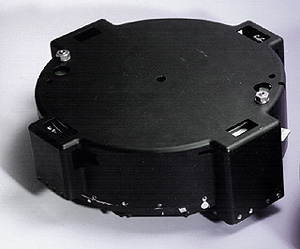![]()
Unlike an aircraft, which uses its attitude to control trajectory by raising or lowering its nose to go up and down, and banking to turn, the angular motion of a satellite in zero gravity has virtually no effect on its orbital trajectory.
Orbit control
Disturbance
forces such as solar radiation pressure cause the satellite's orbit to change
slightly. This means that thrusters must perform small corrections to maintain
the satellite in its Sun-synchronous orbit. Small thruster manoeuvres are
performed roughly once a month to correct the semi-major axis of the orbit.
About once every six months, a larger correction manoeuvre rotates the satellite
and fires its thrusters to correct orbit inclination.
The hydrazine thrusters used for these manoeuvres can generate 15 newtons
of thrust.

SPOT thrusters
Attitude control
Control of the satellite's attitude, i.e., its orientation in space, keeps the optical system pointing at the target area. SPOT 5 achieves this requirement through three-axis stabilization.
Unfortunately, torques generated by residual atmospheric drag on the solar array, by solar radiation pressure and other environmental forces, or by the satellite's own systems (a moving part, for example) tend to modify its attitude. Angular orientation must therefore be actively controlled to keep the satellite stable and prevent image blurring defects caused by unwanted motion.
The attitude control system is a closed feedback loop. Sensors measure the satellite's orientation and the onboard computer processes these measurements to generate commands. These commands are executed by wheels and torquers to maintain a perfect pointing configuration.
Pointing is nominally achieved by:
- Sensors
- An inertial measurement unit composed of four rate gyros measures the satellite's angular velocity; these are two-axis gyros, so two are sufficient to provide angular rate measurements along the three axes; the other two gyros are used as back-ups.
- Two digital Earth sensors, one nominal and one redundant, measure the direction of the Earth's geocentre, i.e., the local vertical.

SPOT 5 digital Earth sensors
- Wheels and torquers
- Three magnetic-bearing reaction wheels apply a torque on the satellite to rotate it about one of its three axes.
- Two magnetic torquers interact with the Earth's magnetic field to generate torques and thus control the speed of rotation of the reaction wheels.

Magnetic-bearing reaction wheel
In certain operating modes (chiefly acquisition and fallback failure modes), thrusters may be used instead of the reaction wheels and magnetic torquers. The thrusters generate a moment arm about the satellite's centre of mass that induces a rotation about one of the three axes.